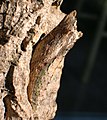Papilio glaucus: Difference between revisions
Meganmccarty (talk | contribs) |
Meganmccarty (talk | contribs) |
||
| Line 43: | Line 43: | ||
Image:Eastern tiger swallowtail.jpg|Eastern tiger swallowtail in Virginia |
Image:Eastern tiger swallowtail.jpg|Eastern tiger swallowtail in Virginia |
||
Image:Eastern Tiger Swallowtail Papilio glaucus Flower 2345px.jpg |
Image:Eastern Tiger Swallowtail Papilio glaucus Flower 2345px.jpg |
||
[[Image:Dark Form Eastern Tiger Swallowtail.jpg]] |
[[Image:Dark Form Eastern Tiger Swallowtail.jpg]] Dark form |
||
</gallery> |
</gallery> |
||
Revision as of 23:56, 25 January 2008
| Eastern tiger swallowtail | |
|---|---|

| |
| Male | |
NE
| |
| Scientific classification | |
| Kingdom: | |
| Phylum: | |
| Class: | |
| Order: | |
| (unranked): | |
| Family: | |
| Genus: | |
| Species: | P. glaucus
|
| Binomial name | |
| Papilio glaucus | |
The Eastern tiger swallowtail, Papilio glaucus, is a large (12 cm wingspan) swallowtail butterfly. It is found in the Eastern United States, as far north as southern Vermont, and as far West as extreme Eastern Colorado. It flies from spring through fall, and most of the year in the southern portions of its range, where it may produce two or three broods a year. In the Appalachian region, it is replaced by the closely-related and only recently described Papilio appalachiensis, and in the north, it is replaced by the closely-related Papilio canadensis. These three species can be very difficult to distinguish, and were formerly all considered to be a single species.
Adult males are yellow, with four black "tiger stripes" on each fore wing. The trailing edges of the fore and hind wings are black which is broken with yellow spots. On the medial margin of the hind wing next to the abdomen there are small red and blue spots.
There are two morphs of adult females, a yellow and a dark one. The yellow morph is similar to the male, except that the hind wings have an area of blue between the black margin and the main yellow area. In the dark morph, most of the yellows area are replaced with a dark gray. A shadow of the "tiger stripes" can still be seen on the dark females. The dark form is more common in the Southern portions of the range, especially in areas also inhabited by the pipevine swallowtail, which it seems to mimic.
Eastern Tiger Swallowtails often rest with their wings fully spread, particularly if the sun is out.
Female lays spherical green eggs on the top of leaves of host plants. After hatching, the caterpillars often eat the shell of their egg. The first instars are dark and mimic bird droppings. The larvae eat the leaves of a wide variety of trees and shrubs, including cottonwood, tulip tree, sweet bay, and cherry. Adults are strictly diurnal; they start to fly towards noon and by and by return to rest throughout the afternoon (Fullard & Napoleone 2001).
It is the state butterfly of Georgia, Virginia, Alabama, South Carolina and Delaware.
Image gallery
-
Two eggs on a tulip tree leaf
-
First instar caterpillar
-
Second or third instar caterpillar showing osmeterium
-
Old caterpillar
-
Female in southern Maine
-
Underside of wings
-
Old yellow-morph female lies dying in a pool of water
-
Eastern tiger swallowtail in Virginia
See also
References
- Brock, Jim P. & Kaufmann, Kenn (2003): Butterflies of North America. Houghton Mifflin Co., New York
- Fullard, James H. & Napoleone, Nadia (2001): Diel flight periodicity and the evolution of auditory defences in the Macrolepidoptera. Animal Behaviour 62(2): 349–368. doi:10.1006/anbe.2001.1753 PDF fulltext
External links
- Eastern Tiger Swallowtail: Butterflies of North Carolina
- Eastern Tiger Swallowtail: Diagnostic photographs Cirrus Digital Imaging
- Eastern Tiger Swallowtail: black female form diagnostic photographs Cirrus Digital Imaging
- USGS treatment









